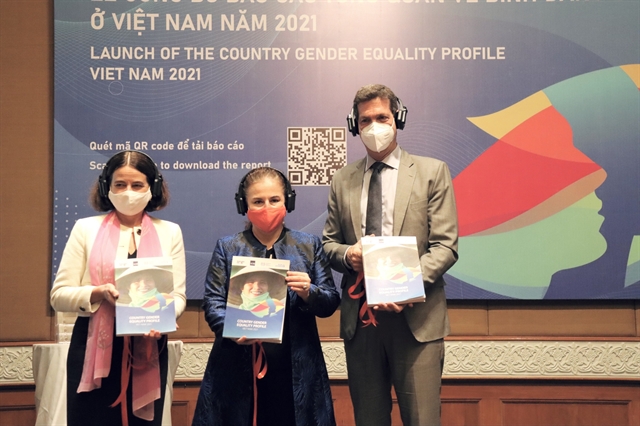 Society
Society

The Country Gender Equality Profile Việt Nam 2021 (CGEP) presents in-depth analysis and focus on gender equality issues based on available evidence, data and research.

|
| Representatives from agencies at the launch of the Country Gender Equality Profile Việt Nam 2021. Photo courtesy of UN Women |
HÀ NỘI — In Việt Nam, women in business still face “social prejudice” including the perception that women’s natural competency was for housework, not in management and business.
Other common perceptions are that women should assume an auxiliary position (second place) rather than assume a top leadership role, that women are unable to concentrate because of their primary focus on caring for their children and family and, moreover, that women are risk averse and not as skilled as men to make bold decisions.
These are some of the findings in the Country Gender Equality Profile Việt Nam 2021 (CGEP) – a report launched on Tuesday by UN Women, the Australian Embassy in collaboration with Asian Development Bank (ADB) and International Labour Organisation (ILO).
The report presents in-depth analysis and focus on gender equality issues based on available evidence, data and research.
The main objective of the CGEP for Việt Nam 2021 is to serve as a primary source of evidence to drive the prioritisation of financing, programming and advocacy to advance gains and overcome bottlenecks to gender equality in Việt Nam. It is intended that the CGEP will also contribute to Việt Nam’s monitoring of gender equality-related targets under the UN Sustainable Development Goals.
When examining gender equality in the economy, researchers found that in Việt Nam, women’s labour force participation rate fell 2.2 percentage points between the fourth quarter of 2019 (76 per cent) to the same period in 2020 (73.8 per cent).
Men’s fell by 2.1 percentage points from 81.4 per cent to 79.3 per cent for the same period.
The gender gap in labour force participation also widened slightly to 10.8 per cent.
COVID-19 contributed to a reduction in working hours for women, and the loss of jobs across manufacturing and services. Younger and older workers were more likely to leave the labour force as a result. Only 30.5 per cent of women with disabilities participate in the workforce and this was prior to the COVID-19 pandemic.
High labour force participation rates tend to mask the fact that women are in more vulnerable employment, according to the report.
Although men are more likely than women to be in informal employment – 78.9 per cent and 67.2 per cent respectively – rates for both are high for a category of workers without job security and social insurance.
However, women are overrepresented in the category of contributing family workers. This is the case for the majority (85.9 per cent) of women working in agriculture. Furthermore, only an estimated 10 per cent of domestic workers hold an employment contract, rendering them one of the most exploitable categories of workers within Việt Nam.
The gender wage gap favouring men has persisted and is currently 13.7 per cent for formal workers. The General Statistic Office estimates the gender earnings gap to be 29.5 per cent, with a gap of 21.5 per cent in urban areas and of 35.2 per cent in rural areas.
Women work similar hours to men and there is no significant difference in educational levels. However, women are overrepresented in the lower paid segment of the labour market and in part time work.
A portion of the gap is also “unexplained” and reflects the structural discrimination and the cumulative “motherhood employment penalty” for women. Ethnic minority women who hold waged employment earn 17 per cent less than their male peers.
According to the report, gender stereotypes profoundly affect women’s economic participation, including barriers to leadership and promotion based on the perceived primacy of their caregiver role which fuels prejudice in relation to woman’s capabilities and knowledge.
Gendered structure economy
In Việt Nam, there is a pervasive notion of women being the secondary earner, while men are considered the primary income earners. This is noted in both urban and rural settings.
Despite advances for women in the economy through increased access to waged work, the economy is “a gendered structure” and women face formal, social and cultural barriers for participating on a par with men.
Factors such as care and domestic responsibilities and being disproportionately represented in more flexible but lower paid and skilled segments of labour market, undermines women’s position in the economy.
It also erodes their resilience to economic shocks and their job readiness for the future labour market.
The Country Gender Equality Profile Việt Nam 2021 (CGEP) – the first of its kind in Việt Nam – also shows and analyses data about Việt Nam’s gender equality progress, framework for gender equality, equality in human development, in economy, in leadership and management, in safety and security, in social life and protection, in a developing Việt Nam and in the future decade.
Speaking at the launch, Australia’s Ambassador to Việt Nam Robyn Mudie said they had invested in this data collection because of a belief in the power of evidence – to stimulate debate, and drive policy, services and opportunities.
Andrew Jeffries, Asian Development Bank (ADB) Country Director for Việt Nam, said that accelerating progress in gender equality was one of the ADB’s operational priorities under ADB’s region-wide Strategy 2030, and they were very pleased to see that the report in particular covered gender analysis in its operational areas in Việt Nam, such as the environment, and urban and rural development.
This report was finalised as Việt Nam was responding to its fourth wave of COVID-19 and, unfortunately, sex-disaggregation of the official case numbers are not available. However, unlike previous global public health and financial crises, COVID-19 has been singularly detrimental for women and girls, and has exposed gendered fault lines in the economy and social structures.
“The COVID-19 pandemic has disproportionally hit women in Việt Nam and exacerbated the persistent gender gaps in the labour market. For instance, this report shows that women’s labour force participation rate fell more than men’s, widening the gender gap slightly to 10.8 per cent,” said Nguyễn Hồng Hà, Officer-in-Charge of the ILO in Việt Nam.
According to the report, among key recommendations to narrow the gender gap in Việt Nam are the needs to develop and implement a national communication strategy to tackle gender-biased social norms using evidence and data on the negative impacts of those norms for the country’s socio-economic development.
It is also necessary to recognise and remove the barriers faced by women in the workplace and business, by promoting equality in access to safe, decent, formal work and equalising access to information, resources and supports such as the access to markets and financing on non-discriminatory and non-punitive terms for women in business.
It is time to recognise, reduce and redistribute women’s unpaid work through public campaigns on a shared division of labour in the household and by facilitating greater investment in gender-responsive social and economic infrastructure such as child/elderly care services. VNS




